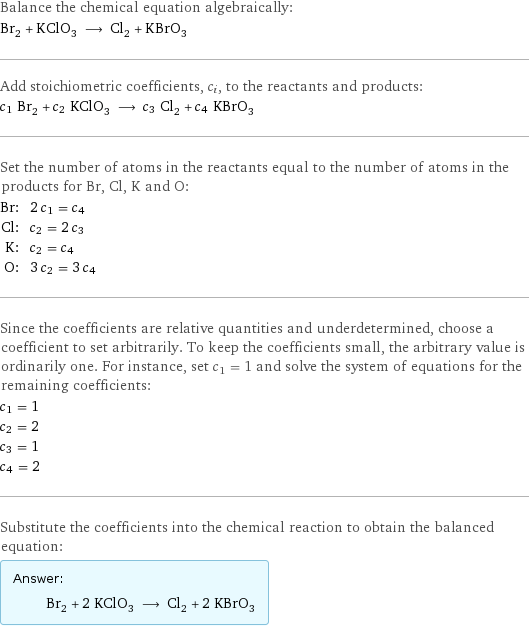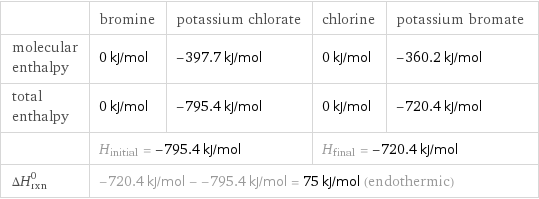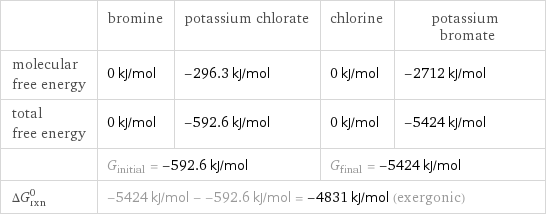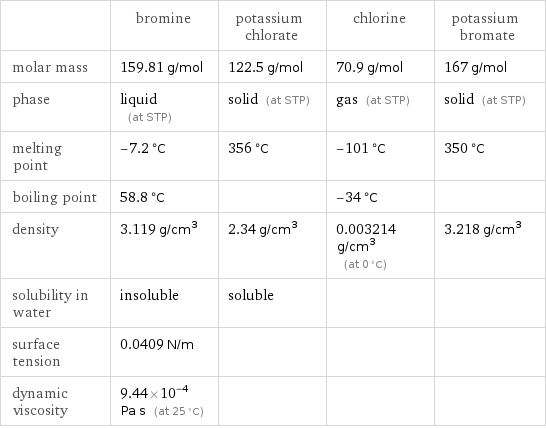Input interpretation

Br_2 bromine + KClO_3 potassium chlorate ⟶ Cl_2 chlorine + KBrO_3 potassium bromate
Balanced equation

Balance the chemical equation algebraically: Br_2 + KClO_3 ⟶ Cl_2 + KBrO_3 Add stoichiometric coefficients, c_i, to the reactants and products: c_1 Br_2 + c_2 KClO_3 ⟶ c_3 Cl_2 + c_4 KBrO_3 Set the number of atoms in the reactants equal to the number of atoms in the products for Br, Cl, K and O: Br: | 2 c_1 = c_4 Cl: | c_2 = 2 c_3 K: | c_2 = c_4 O: | 3 c_2 = 3 c_4 Since the coefficients are relative quantities and underdetermined, choose a coefficient to set arbitrarily. To keep the coefficients small, the arbitrary value is ordinarily one. For instance, set c_1 = 1 and solve the system of equations for the remaining coefficients: c_1 = 1 c_2 = 2 c_3 = 1 c_4 = 2 Substitute the coefficients into the chemical reaction to obtain the balanced equation: Answer: | | Br_2 + 2 KClO_3 ⟶ Cl_2 + 2 KBrO_3
Structures

+ ⟶ +
Names

bromine + potassium chlorate ⟶ chlorine + potassium bromate
Reaction thermodynamics
Enthalpy

| bromine | potassium chlorate | chlorine | potassium bromate molecular enthalpy | 0 kJ/mol | -397.7 kJ/mol | 0 kJ/mol | -360.2 kJ/mol total enthalpy | 0 kJ/mol | -795.4 kJ/mol | 0 kJ/mol | -720.4 kJ/mol | H_initial = -795.4 kJ/mol | | H_final = -720.4 kJ/mol | ΔH_rxn^0 | -720.4 kJ/mol - -795.4 kJ/mol = 75 kJ/mol (endothermic) | | |
Gibbs free energy

| bromine | potassium chlorate | chlorine | potassium bromate molecular free energy | 0 kJ/mol | -296.3 kJ/mol | 0 kJ/mol | -2712 kJ/mol total free energy | 0 kJ/mol | -592.6 kJ/mol | 0 kJ/mol | -5424 kJ/mol | G_initial = -592.6 kJ/mol | | G_final = -5424 kJ/mol | ΔG_rxn^0 | -5424 kJ/mol - -592.6 kJ/mol = -4831 kJ/mol (exergonic) | | |
Equilibrium constant
![Construct the equilibrium constant, K, expression for: Br_2 + KClO_3 ⟶ Cl_2 + KBrO_3 Plan: • Balance the chemical equation. • Determine the stoichiometric numbers. • Assemble the activity expression for each chemical species. • Use the activity expressions to build the equilibrium constant expression. Write the balanced chemical equation: Br_2 + 2 KClO_3 ⟶ Cl_2 + 2 KBrO_3 Assign stoichiometric numbers, ν_i, using the stoichiometric coefficients, c_i, from the balanced chemical equation in the following manner: ν_i = -c_i for reactants and ν_i = c_i for products: chemical species | c_i | ν_i Br_2 | 1 | -1 KClO_3 | 2 | -2 Cl_2 | 1 | 1 KBrO_3 | 2 | 2 Assemble the activity expressions accounting for the state of matter and ν_i: chemical species | c_i | ν_i | activity expression Br_2 | 1 | -1 | ([Br2])^(-1) KClO_3 | 2 | -2 | ([KClO3])^(-2) Cl_2 | 1 | 1 | [Cl2] KBrO_3 | 2 | 2 | ([KBrO3])^2 The equilibrium constant symbol in the concentration basis is: K_c Mulitply the activity expressions to arrive at the K_c expression: Answer: | | K_c = ([Br2])^(-1) ([KClO3])^(-2) [Cl2] ([KBrO3])^2 = ([Cl2] ([KBrO3])^2)/([Br2] ([KClO3])^2)](../image_source/76bd98725aa5ae2d6b8db343141a3705.png)
Construct the equilibrium constant, K, expression for: Br_2 + KClO_3 ⟶ Cl_2 + KBrO_3 Plan: • Balance the chemical equation. • Determine the stoichiometric numbers. • Assemble the activity expression for each chemical species. • Use the activity expressions to build the equilibrium constant expression. Write the balanced chemical equation: Br_2 + 2 KClO_3 ⟶ Cl_2 + 2 KBrO_3 Assign stoichiometric numbers, ν_i, using the stoichiometric coefficients, c_i, from the balanced chemical equation in the following manner: ν_i = -c_i for reactants and ν_i = c_i for products: chemical species | c_i | ν_i Br_2 | 1 | -1 KClO_3 | 2 | -2 Cl_2 | 1 | 1 KBrO_3 | 2 | 2 Assemble the activity expressions accounting for the state of matter and ν_i: chemical species | c_i | ν_i | activity expression Br_2 | 1 | -1 | ([Br2])^(-1) KClO_3 | 2 | -2 | ([KClO3])^(-2) Cl_2 | 1 | 1 | [Cl2] KBrO_3 | 2 | 2 | ([KBrO3])^2 The equilibrium constant symbol in the concentration basis is: K_c Mulitply the activity expressions to arrive at the K_c expression: Answer: | | K_c = ([Br2])^(-1) ([KClO3])^(-2) [Cl2] ([KBrO3])^2 = ([Cl2] ([KBrO3])^2)/([Br2] ([KClO3])^2)
Rate of reaction
![Construct the rate of reaction expression for: Br_2 + KClO_3 ⟶ Cl_2 + KBrO_3 Plan: • Balance the chemical equation. • Determine the stoichiometric numbers. • Assemble the rate term for each chemical species. • Write the rate of reaction expression. Write the balanced chemical equation: Br_2 + 2 KClO_3 ⟶ Cl_2 + 2 KBrO_3 Assign stoichiometric numbers, ν_i, using the stoichiometric coefficients, c_i, from the balanced chemical equation in the following manner: ν_i = -c_i for reactants and ν_i = c_i for products: chemical species | c_i | ν_i Br_2 | 1 | -1 KClO_3 | 2 | -2 Cl_2 | 1 | 1 KBrO_3 | 2 | 2 The rate term for each chemical species, B_i, is 1/ν_i(Δ[B_i])/(Δt) where [B_i] is the amount concentration and t is time: chemical species | c_i | ν_i | rate term Br_2 | 1 | -1 | -(Δ[Br2])/(Δt) KClO_3 | 2 | -2 | -1/2 (Δ[KClO3])/(Δt) Cl_2 | 1 | 1 | (Δ[Cl2])/(Δt) KBrO_3 | 2 | 2 | 1/2 (Δ[KBrO3])/(Δt) (for infinitesimal rate of change, replace Δ with d) Set the rate terms equal to each other to arrive at the rate expression: Answer: | | rate = -(Δ[Br2])/(Δt) = -1/2 (Δ[KClO3])/(Δt) = (Δ[Cl2])/(Δt) = 1/2 (Δ[KBrO3])/(Δt) (assuming constant volume and no accumulation of intermediates or side products)](../image_source/511b4b408b3abf3c62d2556cc5435567.png)
Construct the rate of reaction expression for: Br_2 + KClO_3 ⟶ Cl_2 + KBrO_3 Plan: • Balance the chemical equation. • Determine the stoichiometric numbers. • Assemble the rate term for each chemical species. • Write the rate of reaction expression. Write the balanced chemical equation: Br_2 + 2 KClO_3 ⟶ Cl_2 + 2 KBrO_3 Assign stoichiometric numbers, ν_i, using the stoichiometric coefficients, c_i, from the balanced chemical equation in the following manner: ν_i = -c_i for reactants and ν_i = c_i for products: chemical species | c_i | ν_i Br_2 | 1 | -1 KClO_3 | 2 | -2 Cl_2 | 1 | 1 KBrO_3 | 2 | 2 The rate term for each chemical species, B_i, is 1/ν_i(Δ[B_i])/(Δt) where [B_i] is the amount concentration and t is time: chemical species | c_i | ν_i | rate term Br_2 | 1 | -1 | -(Δ[Br2])/(Δt) KClO_3 | 2 | -2 | -1/2 (Δ[KClO3])/(Δt) Cl_2 | 1 | 1 | (Δ[Cl2])/(Δt) KBrO_3 | 2 | 2 | 1/2 (Δ[KBrO3])/(Δt) (for infinitesimal rate of change, replace Δ with d) Set the rate terms equal to each other to arrive at the rate expression: Answer: | | rate = -(Δ[Br2])/(Δt) = -1/2 (Δ[KClO3])/(Δt) = (Δ[Cl2])/(Δt) = 1/2 (Δ[KBrO3])/(Δt) (assuming constant volume and no accumulation of intermediates or side products)
Chemical names and formulas

| bromine | potassium chlorate | chlorine | potassium bromate formula | Br_2 | KClO_3 | Cl_2 | KBrO_3 Hill formula | Br_2 | ClKO_3 | Cl_2 | BrKO_3 name | bromine | potassium chlorate | chlorine | potassium bromate IUPAC name | molecular bromine | potassium chlorate | molecular chlorine | potassium bromate
Substance properties

| bromine | potassium chlorate | chlorine | potassium bromate molar mass | 159.81 g/mol | 122.5 g/mol | 70.9 g/mol | 167 g/mol phase | liquid (at STP) | solid (at STP) | gas (at STP) | solid (at STP) melting point | -7.2 °C | 356 °C | -101 °C | 350 °C boiling point | 58.8 °C | | -34 °C | density | 3.119 g/cm^3 | 2.34 g/cm^3 | 0.003214 g/cm^3 (at 0 °C) | 3.218 g/cm^3 solubility in water | insoluble | soluble | | surface tension | 0.0409 N/m | | | dynamic viscosity | 9.44×10^-4 Pa s (at 25 °C) | | |
Units
